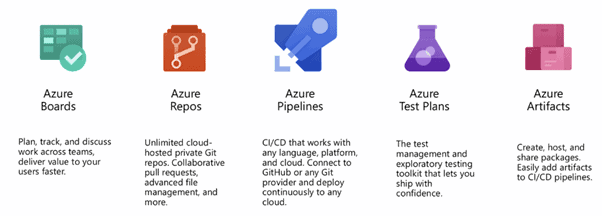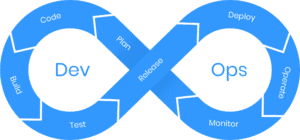Importance of DevOps in IT: Key Challenges and Solutions
The shorter the development cycles, the faster time to market!
The result is faster business outcomes.
If your enterprise is not supporting continuous service delivery to meet the changing customer demands, you are missing out on the mark. Forget driving growth. If you are held back by silos, get ready to face the perils of inevitable decline. Agreed or not, adapting to new technologies faster is the only new mantra for enterprises.
The legacy approach of the past is no longer valid when it comes to accelerating a software product release. The technological disruption and rapid digital transformation are pushing the companies to deliver a convergent experience with high-quality applications. Consumers today are demanding fast-paced and automated business interactions without battling time. To leverage this, many businesses are switching to the DevOps strategy of deploying software using Infrastructure-as-Code. If you are still wondering what is DevOps software in cloud computing, it’s time to get familiar with DevOps terms and methodology.
Remember how the Amazon tech giant succeeded in making a mark with the DevOps approach in 2010? By moving on-premise workloads to the Amazon Web Services (AWS), Amazon achieved a faster and scalable deployment process to whatever servers they need. Such flexible scalability not only resulted in significant cost savings but also higher security, reduced downtime, and more sales! No wonder why Walmart, Netflix, Verizon, Hulu, are the next go-to companies pushing the boundaries of DevOps.
But, not all enterprises could leverage the cloud experience with agile DevOps transition. Sadly, more than 78% of organizations are struggling to implement the DevOps model properly. The reason for this failure is simple. Most organizations are getting it wrong. Companies need an in-depth understanding of the basics of agile methodologies to resolve the complexities faced by the Developers and the Ops. staffs.
So, What Is DevOps?
Dev+Ops = DevOps
To simply put it, DevOps is the combination of development and operation processes for the software development lifecycle to improve customer experiences at a faster pace. Unlike a siloed environment of developers and operations, the development and operations teams are merged throughout the application development lifecycle.
With so much of the ecosystem being open source, DevOps has become another buzzword for enterprises striving for shorter release cycles with more productive developers. The DevOps approach includes several open-source tools to build, test, and deploy applications and services. This helps the enterprises to automate and accelerate application deployment by shortening the release cycles.
What Is Azure DevOps?
If you are not a big fan of Azure DevOps, you will certainly be!
Since the cloud-hosted services belong to the Microsoft Azure Cloud platform, the extension (formerly known as Visual Studio Team Services) was rebranded as Azure DevOps. Interestingly, Microsoft’s innovation is a cloud solution that hosts a series of project management tools to help developers with cross-functional software deployment that are used on-premise. The best part is that using Azure DevOps, organizations can scale across different business units, regardless of teams of any size, much faster and better!
Enterprises leveraging on faster development cycles are adopting the agile methodology of Azure DevOps. However, while tools are a part of the implementation strategy but are not DevOps in themselves. Because, DevOps is much more than infrastructural provisioning, automation, and collaboration.
Regardless of the framework, cloud, or platform, such a high-level autonomy uses a repository of source code to leverage existing tools as well as build and deploy new applications. So what makes it flexible for developers to manage the ongoing software development lifecycle? Its the implementation of continuous integration and continuous delivery (CI/CD)- right from planning to code management, development, to continuous build, test, and deploy.

Image courtesy: https://www.telerik.com
DevOps Model — Why Does it Matter?
No company can exist without a software component and IT. It is not enough for software engineering teams to create a functional format to reorganize the development processes to build and deploy software applications. Rather, incorporating a software development method that entwines communication, collaboration, and integration can identify constraints and reduce handoffs between developers and operations staff. It’s an icebreaker! Isn’t it? With this deadly combination within the ecosystem, the DevOps model can truly achieve that.
So how does the DevOps model increase business agility and regulate the components to accelerate the software release cycle? Let’s dive in.
Improving Visibility with the DevOps Model
DevOps model is a framework that helps you improve collaboration and visibility to foster an agile relationship between the software developers and Ops. staffs. The platform offers end-to-end visibility across a series of product development tasks. These are developments, deployments, code issues, production defects, bugs, application performance, application downtimes, managing releases, and more.
To understand the complete lifecycle of DevOps, let’s figure out the critical phases of achieving faster software development lifecycles.

The different phases of the DevOps model include –
Build –> Test –> Release –> Deploy –> Operate –> Monitor –> Plan –> Code –> Faster deployment
The DevOps framework facilitates continuous improvement across each stage of the development process. In this journey, the Dev. and Ops teams need to collaborate to build a fully automated deployment pipeline. This enables faster delivery and better project management. The CI/CD implementation process deploys small, incremental code changes. This is done by identifying bugs faster, deliver reliable updates, fixes, and features several times a day, instead of releasing application updates every 1-6 months. This ensures less downtime, fewer reliability issues, and of course quick deployment in real-time.
And the biggest benefit (perhaps the best one)? Automated application updates keep the customers happy and satisfied with the fast turnaround of new features! For enterprises, its the word-of-mouth, and showering positive company reviews. Finally, you are at the top of the competition. It’s a win-win, right?
DevOps Roadmap
The DevOps roadmap includes a typical CI (Continuous Integration)/CD (Continuous Delivery) pipeline supported by several other components. This incorporates specialized skills and tools throughout the entire value stream. DevOps approach of the continuous delivery pipeline is broken down into 4 aspects:
- continuous exploration
- continuous integration (CD)
- continuous deployment (CD), and
- release on demand.
However, the pipeline may not strictly be linear.

Image courtesy: https://www.scaledagileframework.com
However, this integrated approach is not devoid of some real-world implementation challenges for software product development. Henceforth, it’s important to consider the key challenges and prepare accordingly.
Key Challenges of Implementing DevOps
For the Development team
The entire concept of the DevOps approach centers around collaboration from cross-functional teams that include Dev. and Ops. However, both teams often fail to understand the core concept. The developer team is more focused on the codes to innovate or build the product. Some of the core challenges that threaten the successful DevOps implementation are:
Challenge #1
During the development cycle, developers are often pressurized for on-time delivery. Experimenting with codes and testing often take time to produce results and then make changes at quick successions. This often delays the process. Since they are expected to meet production-ready code management for new implementations, it often creates chaos and adds to the complexities.
Challenge #2
Since there are numerous tools for implementing DevOps, most of the employees are not skilled enough to use all the tools. Lack of training can invite more challenges during real-time infrastructure integration. This is because every new release has its own set of complications at the backend. The result is delivery delays and red tape with sloppy product outcomes.
Challenge #3
DevOps runs on agility which needs an updated infrastructure to speed up the delivery cycles. Most of the enterprise infrastructure relies on an old legacy system. Old systems are slow and make it difficult for the developers to integrate the latest technologies. This leads to inefficient operational activities, conflicts, and dependencies among both teams.
Challenge #4
Since the development teams are dependent on Ops. teams for deploying software changes, this makes the release cycle more lengthy. The development team is expected to fulfill customer requirements via software updates. This creates a dependency on the operations team for software delivery, thereby, hindering software changes to be released on time.
For the Operations Team
Operators are mainly responsible for managing the stability, uptime, and reliability of the IT infrastructure that hosts the code. The operations make changes to resources, technologies, or approaches as they look for stability. Their challenges include:
Challenge #1
Outdated systems often stand as a roadblock to test, develop, and deploy solutions. The Ops. team faces performance issues and instability of resources if the demands upsurge.
Challenge #2
Because of little or no interaction within the teams and lack of well-defined DevOps practices, the operations team often falls back. While deploying the software that requires handling redesigns or tweaks to run an application, the operations team mostly fixes it in total isolation. This consumes more time than usual.
Challenge #3
The operations team is not familiar with the working model and different tool kits. They often turn to the Development team for repeatable tasks like updating systems, scaling the infrastructure, resolving incidents, automatic code reviews, and production-related issues. Quality and speed are crucial parameters. This leads to a drop in productivity as they take time to adapt to new technologies.
How to Tackle These Challenges Using the DevOps Strategy?
DevOps as a concept sounds great. However, resolving the key challenges that organizations struggle with day-in and day-out due to siloed data sources is not that easy. To make the transition to DevOps strategy smoother and scaling them effectively, consider the following ways to overcome them:
1) Choose the right project to fit the DevOps strategy
Not every project needs the DevOps approach. Based on your business priorities, it’s important to figure out the core working variables, objectives, and project goals. Rather, let your team choose the project actions. Then select the best fit that matches their core competencies to drive the projects.
2) Invest in corporate training sessions
To make the most of the DevOps methodology, it makes sense to educate the combined collaborative team on agile methodologies. This helps them to gain an understanding of the tools so that they can manage product development cycles. Also, this increases the chances of speeding up the release schedule. It is also equally important to select the tools that strategically fit into the right mechanism. In doing so, such tools can perform their best in the development and release of your software builds.
3) Focus on teams integration, rather than tools
Better collaboration=increased productivity.
The need of the hour is to align the organizational goals and priorities of both teams. Both teams should work together cohesively towards a common goal. DevOps practice is a collaborative process that integrates Dev + Ops. teams. Rather than project management goals, teams that adopt cross-functional collaboration and product-aligned goals can achieve more flexible workflows. Besides, such a team integration can also accelerate problem-solving to a great extent.
4) Test your product updates before release
As an integral part of the DevOps process, one of the key drivers of the successful implementation of DevOps is the continuous testing phase. Rather than releasing a large number of applications, it’s always wise to test a small number of new features via the production environment. This ensures-
- accelerated feedback from customers
- superior customer gratification; and
- greater flexibility in deploying the latest changes after the testing stage.
5) Apply DevOps practices to old legacy systems
Obsolete technologies are a struggle while adopting the DevOps strategy as they pose several security threats. Surprisingly, a good number of enterprises still depend on old legacy software because of their familiarity with most users. A legacy system overhaul hurts. Instead, why not embrace certain best practices to get the most from your DevOps initiatives? Certain best practices to apply while adapting legacy to DevOps are:
- automating a large number of legacy codes and processes.
- aligning communication between both teams, collaboration, and continuous feedback.
- continuous integrating and testing to eliminate chances of refactoring old infrastructure.
- enabling continuous integration to identify the bug and rectify it at the component level.
- embracing cultural change that spells a more shared responsibility, transparency, collaboration across teams
- driving effort towards quality assurance and improvement.
Benefits of DevOps for businesses
DevOps strategy is all about speeding up the software delivery applications to generate business value. The ultimate goal is to maximize the development and operations’ teams velocity. This urges an integrated view for each stakeholder with more transparency in progress, goals of quality, and higher fix rates of issues. By adopting microservices-based architectures, teams can collaborate to create functional changes to an application that speed up deployment.
Unlike ineffective and rigid manual work routines, adoption of automated software development cycles can translate the following business benefits: (Tested by high performing organizations as per the survey reports)
- Delivering faster and better applications
- Faster resolution of complex project management
- Smoother and shorter product release cycles, i.e, faster time-to-market
- 440x faster lead time (the amount of time between starting a task till deployment). This means the lead time is less than an hour, unlike a week’s time.
- 46x frequent deployments of codes multiple times a day, unlike once a week or less.
- 23x more usage of deployment patterns for application builds and services
- 5x lower software failure rates or defects i.e, a failure rate dropped to 7.5% from 38.5%
- 96x faster recovery rate from downtime. This means recovery time is less than an hour instead of several days.
In a Nutshell
For organizations staying in silos, certainly, a lot of groundwork lies ahead to achieve operational excellence and business continuity. Increasing the time to market with an ability to “release-on-demand” along with improved service quality are crucial parameters to achieve true success. Teams need to either skill up or scale up to move forward. To achieve this, the first step is to tear down “the wall of confusion” and accept team coordination to align together with DevOps.
However, before you hit the ground running, make sure that you gauge the DevOps benefits against your business outcomes. It’s important to evaluate the challenges of DevOps adoption from the viewpoint of existing structural bottlenecks. By doing this, you can derive a true picture that suggests if it’s worth the risk and effort.
In today’s fast-paced cloud-driven world, more and more businesses are joining the DevOps movement realizing the benefits of adjoining DevOps culture to agile business strategies and practices. Are you lagging behind? Accelerate your DevOps journey with BETSOL’s DevOps solutions that takes the next logical step to break the old siloed mentality and foster collaboration, which is also an extension of the agile approach.


